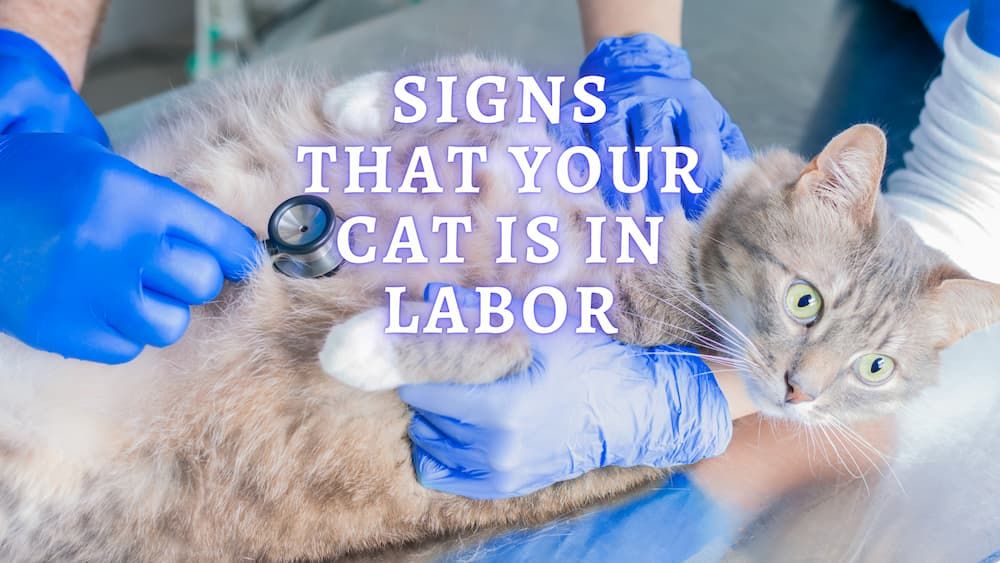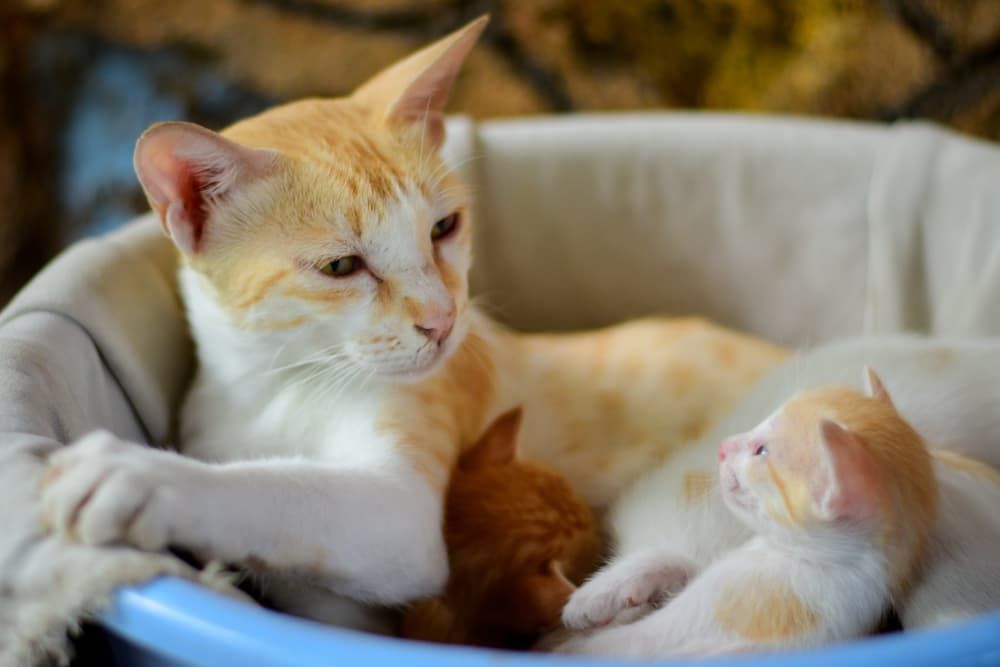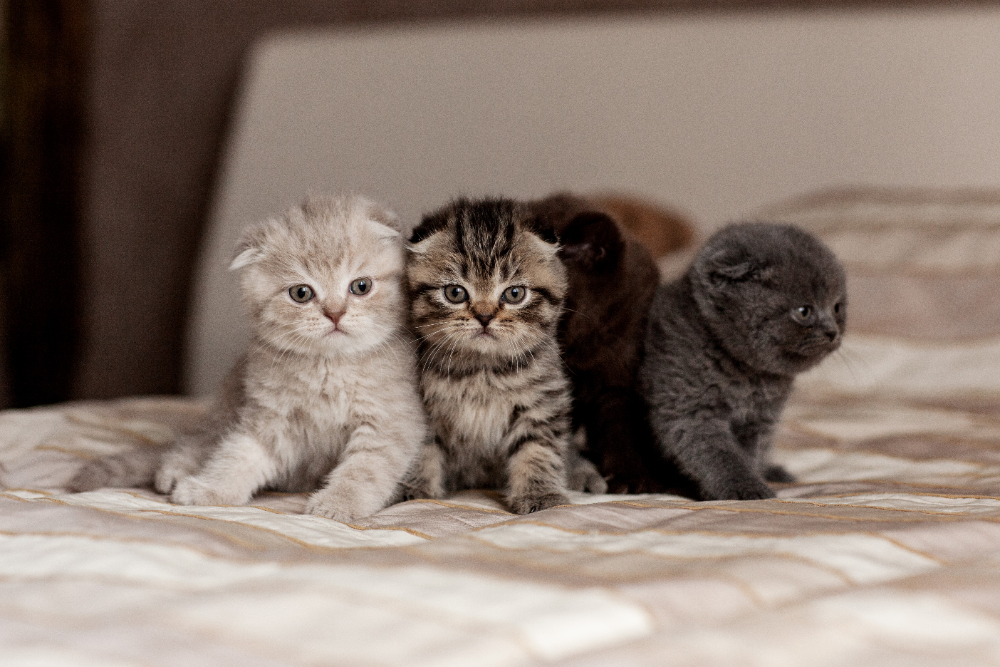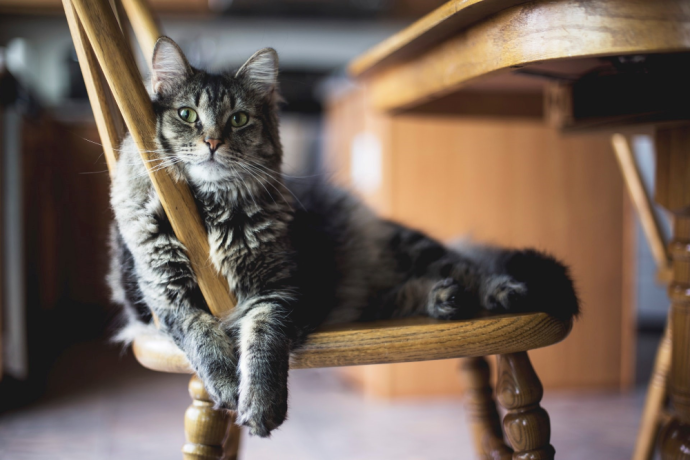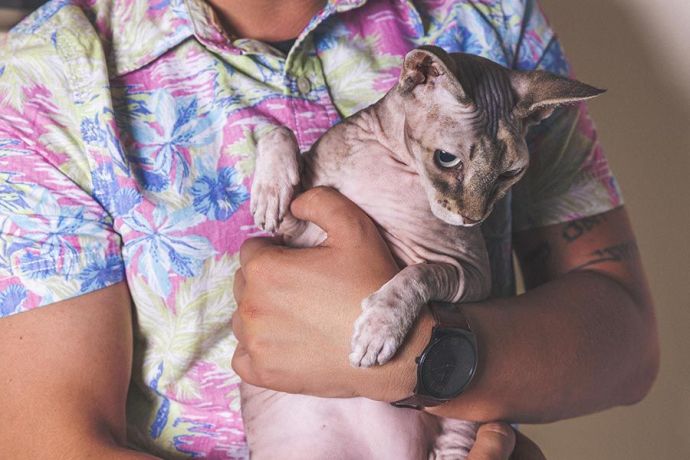Signs That Your Cat is in Labor: How to tell if a Cat is Pregnant?
Written by:
Author: Dr. Chyrle Bonk
Dr. Chyrle Bonk is an associate veterinarian since 2010 and was a volunteer for Clearwater County Youth 4H. Dr. Bonk contributed to various animal and veterinary related websites and magazines as a way to help keep animals across the globe safe and healthy. When Chyrle not working she spends her time with her own furry crew of dogs, cats, and horses.
View all 10 articlesLearn about our editorial process and veterinary review board.
Viewed: 15122
Updated on: 09/01/2022
Whether you planned your cat’s pregnancy, or she took matters into her own hands, her going into labor is an exciting, and maybe even scary time. While most kitties can handle it naturally, there are the occasions when they could use a helping hand. Knowing when your cat is in labor, how long labor should last, and the signs of possible trouble will help ensure that your cat has a successful delivery, and that you will soon have more snugly feline friends in your household.
The Stages of Labor in Cats
Labor isn’t usually a quick and easy process-ask any mother that has labored for 36 or more hours. A cat’s labor signs [1] can be divided into three different stages, which we’ll discuss in detail, but even before that first stage of labor hits, there are a few things to look for as well.
Pre-labor
Knowing your cat’s due date will help you determine about when labor will occur. With planned pregnancies, that due date would be around 63-65 days from the date of breeding, but can vary anywhere from 58-70 days. However, most real-world cat pregnancies are conceived in secrecy, so you won’t have an exact breeding date. You may be able to estimate, however, if your indoor kitty took a three-day hiatus around the first of the month two months ago, but other than that you may not have even a guess at when she was bred.
READ MORE: How to Treat a Pregnant Cat
Even with no due date circled on your calendar, you will still be able to tell when your cat is close to giving birth. You may notice that her mammary glands swell, the nipples turn pink, and they may even leak drops of milk in preparation. Her appetite may decrease, and she will start showing signs of sudden excitement. She will also start ‘nesting’ by looking for a safe haven in which to give birth. Along with this nesting behavior, she may also become more affectionate or clingy to you, or may go in the opposite direction and be more reclusive as she looks for the perfect birthing spot.
A surefire way of determining impending labor is by monitoring your cat’s body temperature. A soon-to-be mother cat’s body temperature will drop below 99℉ 12-24 hours pre-labor.
Following that temperature, drop watch for other signs of labor and make sure that everything is progressing normally. To recap signs of pre-labor in cats include:
- Swollen mammary glands with pink nipples.
- Leaking milk from mammary glands.
- Decreased appetite.
- Sudden jumpiness.
- Nesting-hiding or looking for a safe, comfortable spot.
- Change in behavior-suddenly affectionate or standoffish.
- Drop in body temperature below 99℉.
Labor stage 1:
The first signs of a cat in labor will be restlessness or agitation. She may cry out, howl, chirp, or pant and appear to be looking for something, usually a safe and comfortable place to have her kittens. Don’t be surprised if she moves from room to room meowing loudly even though you’ve provided her with a comfortable bed. She may choose another area to give birth instead.
Contractions start during this stage but are usually intermittent and irregular. You probably won’t even notice them, but you may notice more movement amongst the kittens as they position themselves for delivery.
- Restlessness.
- Agitation.
- Panting, crying, howling.
- Movement in the abdomen.
READ MORE: Kittens First Vet Visit
Labor stage 2:
This is when the contractions become very strong. Once contractions start, you should see a kitten within four hours. She may pass a bit of clear or blood-tinged discharge before a kitten appears. If the discharge is dark brown or black, you should see your veterinarian immediately. Stage two lasts through the delivery of the final kitten.
The time between the birth of each kitten is variable and can be as quick as 10 minutes or as long as an hour. However, it’s not uncommon for a mother cat to go into interrupted labor where she delivers some, but not all, of her kittens, relaxes, takes care of her new babies and then returns to labor 24 or even 36 hours later!
- Visible contractions.
- Passage of blood-tinged discharge.
- Birth of kittens roughly at least one per hour.
Labor stage 3:
Stage three is the passage of the afterbirth or placenta. The fetal membranes of each kitten should be passed immediately after each kitten, leaving the shared placenta to be passed last. The placenta will come out as a greenish-black ball soon after the birth of the last kitten. Don’t let the color and appearance of the placenta alarm you. Dark greenish-black and slimy is perfectly normal.
- Passage of the placenta which will be green or black and slimy.
- No more contractions.
- Mother cat should noticeably settle down and start nursing kittens.
READ MORE: Cat lost Voice
How to Help Your Cat Prepare for Labor
Cats have been having kittens without our help for many years and continue to do so to this day. However, being there for support and in case something goes wrong is never a bad idea. Here are some things you can do to make the process a little more comfortable for your kitty.
Gather necessary supplies. [2] Have her birthing bed ready along with a few emergency supplies.
- Clean towels to help dry the kittens if necessary.
- Dental floss and sharp scissors to tie and clip the umbilical cord if necessary.
- Iodine or other disinfectants to touch on cords to prevent infection.
- Kitten milk replacer [3] and dropper bottle in case you need to feed any.
- Your veterinarian’s phone number in case of any concerns.
Help her find a good spot.
While your cat definitely has the final say in where she has her babies, you can help persuade her by setting up a clean, warm, and comfortable bed. A cardboard box lined with newspaper, puppy training pads, [4] or old towels works well as it can easily be cleaned up and disposed of. Place it in a spot that’s secluded yet observable to help her feel safe but still allows you to keep an eye on things.
Try to set up the bed a week or so before her expected due date so that she has time to get familiar with it. Place her in the bed and pet her or feed her so that she knows it’s safe. Don’t be surprised if your cat never does come on board with your chosen bed and instead chooses her own. Whatever the case, try to keep her within view in case there’re any troubles.
During labor, be sure to observe.
This doesn’t mean that you’re sitting by her side, constantly holding her paw. Rather just be sure to check in frequently to make sure her signs of labor are progressing as they should.
After all the kittens are born, make sure they have all nursed and then place them and the mother in a safe, warm spot.
She may move them around after a few days to a place that’s more of her liking, but at least you have given her some options. It may help to keep her in a small, fairly empty room so that she can’t move them too far or hide them from you.
If there are many kittens in a litter or mom seems disinterested in one or all, you may end up bottle-feeding.[5]
Speak with your veterinarian about what and how to feed a newborn kitty if you need to.
READ MORE: Best Automatic Cat Feeders
What Are Complications That Can Occur With a Cat in Labor?
Even though most kitten deliveries go smoothly and uneventfully, sometimes complications do arise. Knowing what normal is will help you to identify if there is a complication so that you will be able to help.
1. Dystocia
Dystocia simply means difficult birth. It can occur because of an abnormal size or an abnormal position of the kitten. Signs of dystocia would be if your cat is straining hard for more than 20 minutes without delivering a kitten or if she strains for more than 10 minutes with a kitten visible in the birth canal. If your cat is lethargic, depressed, or running a fever even with no visible straining, or it here’s excessive bleeding from her vagina before, during, or after labor, see your veterinarian.
2. A kitten is born sluggish or unresponsive
If a kitten is born sluggish or unresponsive, you can help resuscitate or stimulate. This involves clearing the membranes away from their mouth and nose and tilting their head down to allow for further drainage. A bulb syringe can be used for further suction if needed. Rub the kitten vigorously with a towel to stimulate breathing. You can also try puffing very small breaths of air into their mouth if all else fails. Have your veterinarian show you how to do this and practice with you before delivery so that you’re comfortable if the need arises.
3. Fetal membrane retention
If your cat doesn’t pass the fetal membranes and placenta immediately following birth, see your veterinarian. If left inside, they can start to decompose leading to a severe illness and infection. When you weren’t present to know whether fetal membranes were expelled during stage three, other signs of retention would include a brown, smelly discharge, restlessness, poor appetite, ignoring her kittens, abdominal pain, or fever.
Frequently Asked Questions
How can I tell if my cat is pregnant?
A cat’s gestation period is around 60 days, or two months. The first 30 days are pretty uneventful as far as what you’re going to see. Around the 30-day mark, you may start to notice that your cat’s belly is getting bigger and firmer. You may also notice that her nipples are getting firm and darker pink. As the days go on, you’ll notice further growth of her belly, a decrease in appetite, and her starting the nesting behavior. She may also change in her behavior towards you or other pets in your household by either becoming overly affectionate and clingy or more standoffish and agitated.
The most definitive way to know if your cat is pregnant is to see your veterinarian. They will diagnose pregnancy based on feeling your cat’s belly, through ultrasound or x-rays.
Ultrasound can be used after 21 days gestation and x-rays after 45 days.
What are early signs of cat pregnancy?
You aren’t going to notice much difference in your pregnant cat [6] until they are about 30 days pregnant. Some kitties may go through a similar morning sickness phase early on, like humans do, where they will have a decreased appetite or appear nauseous. But for the most part, any change in their belly, nipples or behavior won’t happen until around 3-4 weeks gestation.
It is then that you may start to see a larger, firmer belly and darkened nipples.
What are the signs of a cat going into labor?
As your cat’s day gets nearer, you may notice a decrease in her appetite, see her starting to nest, and a change in behavior to where she becomes more affectionate or more standoffish.
Her body temperature will drop to below 99℉ 12-24 hours before delivery. You may also notice that she becomes more vocal, howling, crying or chirping as she restlessly moves about your home. She may pant or hide as she tries to get comfortable. Early, weak contractions may be visible, as well as movement of the kittens as they position themselves for delivery.
Final Thoughts
Your cat going into labor is the culmination of a two-month journey that the two of you have hopefully been on together. Knowing the cat labor signs will help you determine when the big event will take place, and if things are proceeding normally. It’s important to remember that there can be great variability in the duration of labor. For some kitties it’s over in a couple of hours, for others that go into interrupted labor, it can even be days. Just trust your gut and see your veterinarian if you have any laboring questions along the way or if things seem a little abnormal. With the proper reparation, including knowledge of the laboring process in cats, you can help your kitty sail through labor and delivery and safely produce a healthy brood of feline friends.
Article Sources:
- Williams, Krista. “Pregnancy and Parturition in Cats.” VCA Hospitals, vcahospitals.com/know-your-pet/pregnancy-and-parturition-in-cats.
- “5-Point Checklist for Owners Expecting Kittens.” MedicAnimal, medicanimal.com/5-point-Checklist-for-Owners-Expecting-Kittens/a/ART111479.
- “Recipes For Homemade Kitten Formula.” Kitten Rescue, 7 Apr. 2019, kittenrescue.org/2017/03/recipes-emergency-kitten-formula/.
- “Wee-Wee Puppy Training Pee Pads 50-Count 22″ x 23″ Standard Size Pads with Febreze.” Amazon, amazon.com/Four-Paws-Wee-Wee-Febreze-Absorbent/dp/B07GS5VM38/.
- Miller, Joni. “Bottle Feeding Kittens.” Best Friends Animal Society, 2 Aug. 2018, resources.bestfriends.org/article/bottle-feeding-kittens/.
- Desfosse, Rebecca. “5 Signs Your Cat Might Be Pregnant.” Care.Com, 18 May 2020, care.com/c/stories/6375/how-to-tell-if-a-cat-is-pregnant-5-tell-tale/.
 Cat Veterinary Tips Down Syndrome Cat: Can Cats Have Down Syndrome? (Vet Advice)
Cat Veterinary Tips Down Syndrome Cat: Can Cats Have Down Syndrome? (Vet Advice) - 1360
- 0
 Cat Veterinary Tips Cat Stomach Gurgling: Vet Advice on Why is Your Cat Stomach Gurgling?
Cat Veterinary Tips Cat Stomach Gurgling: Vet Advice on Why is Your Cat Stomach Gurgling? - 36469
- 4
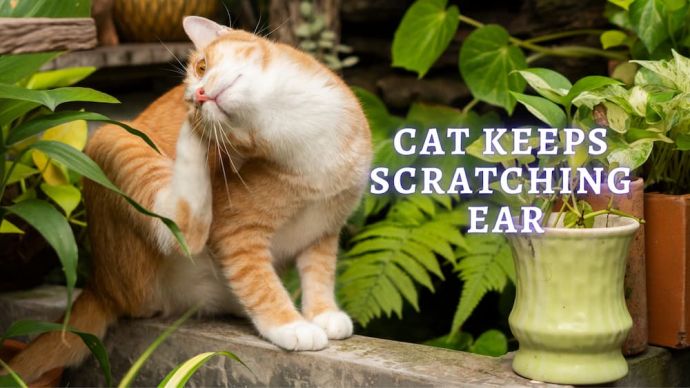 Cat Veterinary Tips Why is my Cat Scratching their Ears? (Veterinary Advice)
Cat Veterinary Tips Why is my Cat Scratching their Ears? (Veterinary Advice) - 1361
- 0
 Cat Care Why Does My Cat Attack My Legs? 10 Reasons Why and What To Do About It (Vet-Approved Advice)
Cat Care Why Does My Cat Attack My Legs? 10 Reasons Why and What To Do About It (Vet-Approved Advice) - 46013
- 21
 Cat Veterinary Tips Cat Stomach Gurgling: Vet Advice on Why is Your Cat Stomach Gurgling?
Cat Veterinary Tips Cat Stomach Gurgling: Vet Advice on Why is Your Cat Stomach Gurgling? - 36469
- 4
 Cat Veterinary Tips My Cat Lost its Voice: Can Cats get Laryngitis? (Vet Advice)
Cat Veterinary Tips My Cat Lost its Voice: Can Cats get Laryngitis? (Vet Advice) - 23554
- 13









